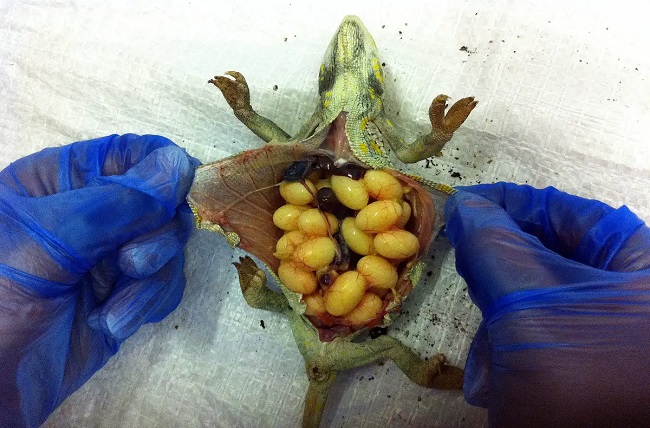As an intriguing blend of vibrant colors and eccentric characteristics, chameleons are undoubtedly one of the most fascinating creatures in the reptile world.
One question that often piques the curiosity of reptile enthusiasts and prospective chameleon owners alike is, “Do chameleons lay eggs?”
In this comprehensive guide, we’ll delve deep into the subject of chameleon reproduction, covering everything from their mating behavior to egg-laying process.

Do Chameleons Lay Eggs?
The answer is no, not all chameleons lay eggs. While most chameleon species are oviparous (egg-laying), there are a few that are ovoviviparous, meaning they give birth to live young.
For instance, the Jackson’s chameleon is well-known for its live births, which sets it apart from the majority of its egg-laying counterparts.
Read Also:
Understanding the Egg-laying Process
Egg-laying chameleons follow a particular process that begins with mating. Female chameleons lay eggs approximately 30-45 days post-mating, and the number of eggs varies significantly from one species to another.
The Veiled chameleon, for instance, can lay clutches of up to 80 eggs, while Panther chameleons lay around 30 eggs per clutch. Once the female is ready, she’ll dig a tunnel or a hole in moist soil or sand, where she will deposit her eggs.
This process can last several hours, and disturbance should be minimal to avoid causing stress to the chameleon. After laying, the female covers the eggs with soil and leaves them to incubate.
Incubation and Hatching of Chameleon Eggs
Depending on the species, chameleon eggs require a specific temperature and humidity level to incubate successfully. Generally, the incubation period ranges from 4 to 12 months. As the embryos develop, the eggs change from a pinkish hue to a greyish-white color.
Once the incubation period is over, tiny chameleons, fully formed, break out of the eggs. They are usually self-sufficient from birth, requiring little to no parental care.
Caring for Chameleon Eggs
If you are breeding chameleons in captivity, proper care of the eggs is essential. Maintain the right temperature and humidity levels in the incubator and monitor the eggs regularly for any signs of mold or other issues.
It is also crucial to provide the laying female with proper nutrition and hydration to ensure her health post-laying.
What Factors Can Influence Chameleon Egg Development?
The successful development and hatching of chameleon eggs can be influenced by several factors. It’s important to note these elements, as any variations can significantly affect the development and the viability of the eggs.
1. Environmental Conditions
Environmental conditions play a crucial role in the egg development process. Variations in temperature and humidity can have adverse effects on the eggs’ development. Ideally, the incubation temperature should be between 72°F and 80°F.
If the temperature is too high or too low, it can lead to premature or delayed hatching, or in worst cases, no hatching at all.
Likewise, the humidity level should be maintained at 50% to 70%. Too much humidity can cause molding, while insufficient humidity can cause the eggs to dry out.
2. Nutrition of the Mother
The health and nutrition of the female chameleon during the gestation period can also influence the viability of the eggs. A balanced diet rich in calcium and vitamins is crucial during this period. A lack of proper nutrition can lead to weak eggshells and affect the overall development of the eggs.
3. Genetics
Just like in all animals, genetics also play a role in chameleon egg development. Some chameleon species naturally have a higher success rate in terms of egg viability compared to others. Therefore, it’s essential to research about the specific breed you are interested in before deciding to breed them.
4. Handling and Disturbances
Minimal handling and disturbances are key to the successful hatching of chameleon eggs. Frequent handling can cause stress to the eggs and lead to developmental issues.
Read Also:
Conclusion
In conclusion, while most chameleon species lay eggs, a few give birth to live young. Understanding the unique reproductive habits of these remarkable creatures is not only fascinating but also vital for any potential chameleon keeper.
Always remember, if you decide to breed your chameleons, caring for the female and the eggs is paramount for successful hatching.
If you found this information helpful, feel free to share it with other reptile enthusiasts. For more insightful articles about chameleons and other exotic pets, bookmark our page and stay updated with our latest posts.
























